October
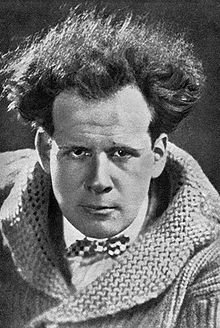
(Soviet film director Sergie Eisenstein.)
My Russian Natasha told me to order a copy of Sergie Eisenstein’s film “October” from NetFlix.
I complied, and it has been sitting on in the pile on the media center for months- maybe since last October, I don’t know. I got energized, though, since I am in a minor war with the video content distribution giant, as you well may be. Better said, they are at war with us. I was surprised to get a note from my friends there- apparently they consider me a friend- saying they were unilaterally changing their business model.
I would consider myself more of a comrade than a friend, having been down the technological rapids with Betamax and Blockbuster, and the painful late charges there, and the midnight drunken rides to get the tape back to the store before incurring late charges, I am sympathetic. It is the essence of capitalism that things change and things are destroyed, like the ubiquitous video chain was eaten alive by the little red envelopes providing DVDs are about to be destroyed by streaming content on the computer.
If I ever solve the riddle of hooking up my spare computer to the television, I will be done with the snail-mail distribution of video content. Or maybe just watch films on the iPad. But in the meantime, NetFlix announced that it was going to start charging for direct download as well as the physical distribution of DVDs by mail.
The new plan, if I stayed with the “two discs out at any given time” and accepted the $8 bucks a month for unlimited streaming would have jumped several dollars. I don’t watch that much content, and never seem to get to the two red envelopes near the flat screen, so I made getting rid of them a priority.
What happened to be there was “The Social Network,” a wonderful and more than a little creepy film about another software program that lives on my computer, and the copy of “October: Ten Days that Shook the World.”
It took me two sessions to complete both, but it was well worth it. The former was about the ruthless application of technology and capitalism, and the latter was an old-school approach to the destruction of the same, filmed as part of the ten-year celebration of the Bolshevik Revolution of October (or November, if you are still using the Gregorian Calendar).
I understand there is an app for that, but I digress.
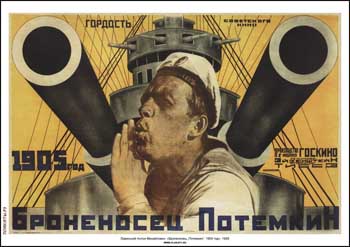
I have always enjoyed Eisenstein’s. Back in the unsettled days of the 1960s, there were film festivals that celebrated the icons of revolution. Eisenstein’s great film “Battleship Potemkin” was frequently screened, and rightly has been recognized since 1925 as a triumph in the art of cinematic montage, and joyful propaganda. Since it was a silent movie (like “October,”) a simple update to the language of the title cards made the films instantly accessible to any language group.
I fell asleep to images of the righteous proletarians, soldiers, women and sailors in about that order sweeping away the ancient regime, and awoke to the scene-select menu and the endless repetition of the overture. I was determined to get right with Netflix and started the movie again about where I dropped off. It was awesome; a triumph of the will, if I may be permitted an allusion to Leni Riefenstahl’s scary masterpiece of the Munich Partitag of 1934.
She obviously owes a debt to the montage approach pioneered by Sergie, who was exactly the sort of Communist Hollywood was willing to invite to produce films. He had come under fire back home for his creative approach to camera angles and film editing, which were at variance with the increasingly specific doctrines of socialist realism.
Eisenstein got out of Russia, first to Europe, ostensibly to learn more about emerging film technology. In late April 1930, Paramount Pictures offered him a $100,000 to come and make films in Hollywood. In the end, idiosyncratic approach and artistic temperament were incompatible with the way the Studios did business, though he found a sympathetic ear in stars like Charlie Chaplin, and progressives like Upton Sinclair.
The American approach to cinema, in its commercial basis, was as rigid as Socialst Realism and just as hostile to free thinking. Plus, there was a determined anti-communist presence in California and the whole experiment was abandoned by mutual consent.
Eisenstein wound up in Mexico to make a six-film epic for Mary Sinclair and hung out with iconic artist Frida Kahlo and fresco master Diego Rivera, whose work about the ferocious capitalism of the auto industry famously adorns the lobby of the Detroit Institute of Arts.
Artistic disputes with the Sinclairs resulted in the loss of miles of negative, and Eisenstein returned to Russia, where he escaped the fate of Boris Shumyatsky, his executive producer at Mosfilms, who was denounced, jailed, tried and shot.
You can almost hear the theme music rising, since after the loss of his Mexican work, failure in Hollywood and disastrous return to the Soviet film industry, he made the critically acclaimed “Alexandre Nevsky.” Stalin was pleased. The script made use of a number of traditional Russian sayings, which was a thinly disguised warning about the growing strength of Nazi Germany.
Sergie was awarded the Order of Lenin and the Stalin Prize, and life was good until the non-aggression pact with Hitler was signed and “Nevsky” was abruptly pulled from theatrical release. Eisenstein was then assigned to do a production of Wagner’s “The Valkyries” at the Bolshoi Theater.
I really enjoyed my visit to the Bolshoi, years ago. The socialist realist art is better than the stuff at the Detroit institute of Art. Oh, and Nevsky was reinstalled on the Russian theater circuit the instant the Nazis crossed the frontier in June of 1941.
The cool thing about command economies is how agile they can be, you know? It was lucky that he came in with a winner at the beginning of the Great Patriotic War, since his vision of Communism was at variance with Socialist Realism. Like many Bolsheviks, Eisenstein envisioned a society that would subsidize artists totally, freeing them from the confines of bosses and budgets, leaving them absolutely free to create a pure new art.
Of course, as it turned out, budgets and producers were as significant in the Soviet film industry as it was in Hollywood. Sergei died in 1948 at the age of 50. I saw his grave at Novodevichy Cemetery the same trip we got to the Bolshoi.
Anyway, I am going to have to get rolling. I may get “Battleship Potemkin” from NetFlix, if I remember to add it to my queue. There is something stirring about a rebellion.
Not that there is anything going on downtown that would cause anyone to get upset about government, you know?

(Eisenstein grave in Moscow.)
Copyright 2011 Vic Socotra
www.vicsocotra.com
They Tried to Make Us Go to Rehab

(Late Chanteuse Amy “Wineglass.” Photo UPI)
Europe has begun to question the sanity of the debate in Washington, which ought to come as no particular surprise. A pal send me a note that quoted Vince Cable, a Conservative member of Prime Minister David Cameron’s cabinet (and Hillary Clinton’s opposite number) as saying a deal on the budget crisis was being held up by “a few right-wing nutters in the American Congress.”
Getting lectured from Europe, and by our special friend in particular strikes me as being an intervention moment. I am thinking the late Amy Winehouse’s anthem might be the theme song for Congress: “they tried to make me go to rehab, I said No, No, NO….”
Apparently Speaker John Boehner tried. He told lawmakers from his party to “get your ass in line.” They got to an a-ha moment in the August chamber last night when the votes were not there, and they dropped the debt ceiling bill and switched over to a bill naming post offices across the country.
Yep. Looney tunes. They are supposed to try again today, and bless their little pointy-heads, maybe they will do something. I have not looked at anything in detail this morning, but I do think that the Speaker and Majority Leader will get something President to sign. But there are the those who would prefer to melt it all down like a grilled cheese sandwich.
Did you know that July is National Hot Dog Month? See?
So we ignored the whole thing at Willow, except to comment that if the country is going to go to hell in a hand-basket, well, we may as well enjoy the ride. The restaurant was doing a brisk business. Manager Deb said they moved three hundred meals the night before, a function of the GroupOn coupon promotion with which they are experimenting.
“Does that include the neighborhood bar menu?” I asked.
Deb shook her head. “Nope. Three bar snacks count as a meal.”
“Interesting,” I said. “I guess I can eat more.”
Doc promptly ordered the Gruyere Cheese Puffs with black truffle sauce, the miniature fish and chips, and an order of the Pollyfarm deviled eggs.
Old Jim held down his pulpit position at the Amen Corner of the bar. Santa came back from the wilds of Fairfax for a re-engagement, and was adopted as an honorary local. The Doc was there for his monthly appointment, and my old Boss from the Phone Company and his lovely bride made a surprise guest appearance.
Our pert buddy Holly kept us topped up and I have to say Elisabeth-with-an-S never looked as lovely and poised as she did last night, wending her way through the crowd with her tray elevated above her head, bringing wine, beer and mixed cocktails to slake the thirst of the ravenous GroupOn bargain seekers.
Things got blurry enough that Adam the Polish Life Guard had actually locked the pool gate on me, ten minutes early, but I was able to track him down and get at least a plunge in the refreshing water before he peddled his bicycle off into the night.
I made a note to check my bank account the next morning and see if the VA check actually hit- naturally, I realize I am part of the problem, along with everyone else who expects their money from Uncle Sugar- and since I am managing the folks affairs, their Social Security deposits are a pretty big deal to me in meeting their monthly requirements.
The Right Wing Nutters, in the words of the British Foreign Secretary, want Mr. Obama to be a one-term president and many appear to be willing to put that ahead of the welfare of the nation.
There are some people throwing the “treason” word around, though I don’t know about that. I remember the things they said about Bush II, which included incitement to violence. The default value of the rhetoric from both extremes is so over the top that it is surreal. This does not have to be a constitutional crisis, any more than any rational government would run a trillion dollar deficit in a single year.
I had a friend who honestly was concerned that the Army would not intervene if the President dismissed the Congress and suspended habeas corpus like Mr. Lincoln did. I am serious. That is the level of discourse about this. As an American, I think we all ought to be sent to our rooms, or to rehab with Amy.
Oh, I forgot. It is too late for Amy to do anything.
The divide about where the nation should go is so deep and profound that I have not seen its like before. Certainly in the absence of a peer enemy we have never been in such disarray, and our biggest foe is us and our outsized appetites for everything.
We need to do something that shows we are actually going to do something to start the long road back to solvency. If the President gets credit for it, fine. He is a smart guy, but it is painfully evident that his background did not prepare him to run something as complex as the executive branch. “Dropping the ball” is a charitable way to put it.
Every President has committed foes- Mr. Obama’s are just a little nuttier than the ones most Commanders in Chief have to deal with, but you can’t say he did not bring some of it on himself. Withdrawing into his small circle of trusted advisors was not the way to go. Like the debt ceiling, he dithered for weeks over the bin Laden mission on advice of his counsel, and in the end, Panetta did it himself.
Oh well. God bless the United States of America. I doubt anyone else will.
Have a great weekend, and remember, it is National Hot dog Month. I am going to stay away from rehab. No, No, NO.
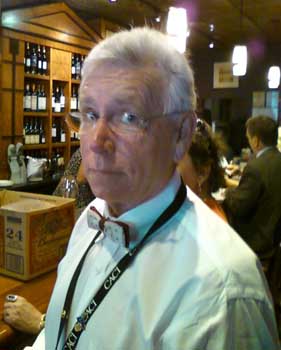
(Vic at Willow and skeptical. Photo Santa.)
Copyright 2011 Vic Socotra
www.vicsocotra.com
The Abilene Paradox
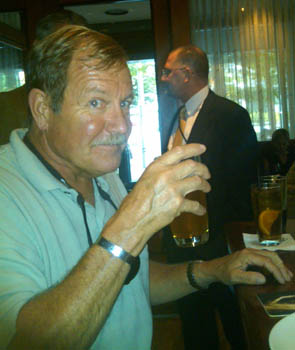
(Santa with a cool IPA at the Amen Corner at Willow. Photo Socotra.)
Jerry B. Harvey was not at Willow last night. Jerry could have been, though, since he is a
professor of management science at the George Washington University right here in Your Nation’s Capital. He is a smart guy, and I thought about him in the context of the national drive to Abilene, Texas we have been taking in the American convertible driven by Thelma and Louise these last few weeks.
I will get to that in a minute, but you know how hot and dusty it has been down in Texas of late, sort of like Somalia, and it is not a place you would go to willingly if you had a choice.
But of course, we had choices, and we made them and drove on.
This has been a mostly Willow Week; it started with a business lunch with a colleague who is doing something I have been afraid of for a long time. He is venturing out from under the corporate umbrella and setting up his own company. It might be the best of times to do that, or the worst, but I was filled with admiration as we talked through some of the key milestones in the process.
Then, back for happy hour, and then a business social on Tuesday, and Santa was in town and made the effort to slog down in the afternoon traffic from his training session out in the wilds of Fairfax.
I had not seen him since he flew off the big gray boat in 1980, or thereabouts, making it 31 years since we had been more than a virtual presence in each others lives. Not that we were not in touch daily- and there were lives entwined, and lives gone by in the years between. So it was good, and I wanted him to meet Old Jim, and Jon-no-H, and Short Haired Mike and manager Deb and our buddy Holly and Elisabeth-with-an-S and sultry Nina and the rest of the cast of characters.
There was an air of merriment, since Jon-no-H has just rejoined the ranks of the employed, a signal accomplishment in this economy. He is going to be a lobbyist for the National Association of Associations, and develop opportunities for his industry, which used to be wind power, and now is hot hair.
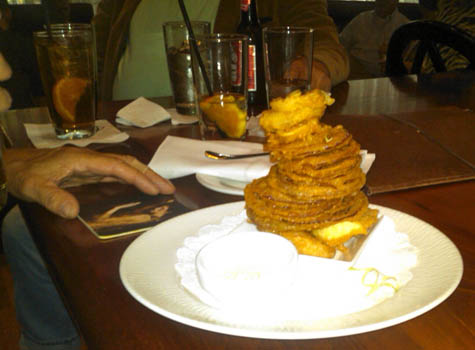
|(Willow Neighborhood Bar Menu miniature fish and chips tempura. Photo Socotra)
It was good. We played with the Miniature Fish and Chips and the Spring Rolls off the famous Neighborhood Bar Menu and talked about old times and new ones. Santa has some new ink on his arm, an impressive work in tribute to a design done by his son, who left us just weeks ago. His bride the lovely Dawn got a stunning work done on her back as well, something to keep his son’s memory alive.
Anyway, there was that, and recollections of Uncle Snidely, who left us in December of 2004. Now there was a man who would have liked Willow. We still miss him a lot.
Anyway, we talked about a lot of things, and the road to Abilene came up, what with the stupidity happening downtown. See, I was at Harvard’s JFK School of Government through one of those government flukes, and they like the case-study approach to teaching public policy. The one I liked was Jerry B Harvey’s trip to Abilene. It went like this:
“It was a blistering July afternoon in small-town Coleman, Texas. The wind was blowing fine-gained West Texas dust through the house, fans were roaring and there was cold lemonade. I would have opted for the cool darkness of an air-conditioned bar, but that wasn’t the point. It could have been a perfectly fine small-town afternoon, spent inside out of the blast furnace, but Jerry’s father-in-law suddenly got a wild hair and announced the intention to drive fifty miles across the blasted brown soil to Abilene and have dinner at the Luby’s Cafeteria. In the family’s un-air-conditioned 1958 Buick, the model the Chinese consider the paradigm of auto art. Jerry’s wife, for whatever reason, agreed. Jerry hated the idea, but went along in the name of family harmony, hoping his Mother-in-law would inject some sense into things. It was not to be.
“Of course I want to go,” said his mother-in-law. “I haven’t been to Abilene in a long time.”
So into the car and off to Abilene they went. Jerry’s worst apprehensions were fully realized. It was hotter than bad sin, the sand and dust blew in the open windows of the stifling hot automobile and mixed with sweat and turned to sandpaper under sodden clothing. Luby’s, when they finally arrived, featured industrial-grade chicken-fried steak and wallpaper-paste potatoes.
Four hours later they were back in Coleman, exhausted, hot and hostile.
Jerry broke the silence, trying to loosen everyone up. “Great trip, wasn’t it?”
Dead silence. Finally, the mother-in-law said, with some irritation, “Well, to tell the truth, I really didn’t enjoy it much and would rather have stayed here. I just went along because the three of you were so enthusiastic about going. I wouldn’t have gone if you all hadn’t pressured me into it.”
“I didn’t want to go, either, said Jerry.
His wife looked at him in disbelief. “I only went because you guys wanted to.”
The father-in-law, the one who suggested the trip, scowled. “Hell, I only suggested it because I thought your guys were bored. You don’t come to Coleman very often.”
After the outburst of recrimination they all sat back in silence. Four reasonably intelligence people had just willingly taken a hundred mile trip across a godforsaken desert in a furnace-like temperature through a cloud-like dust storm to eat unpalatable food at a hole-in-the-wall cafeteria in Abilene, when none of us had really wanted to go.”
Santa had another Racer 5 India Pale Ale, which Jim the bartender had recommended after a brief survey of Santa’s taste. “I imagine it is hot in Abilene this July, too,” he said. “And who was driving, anyway?”
“I think it was Thelma and Louise taking turns,” I said. “Wild ride.”

(Thelma and Louse take a road trip. Photo Ridley Scott.)
“I imagine so,” said Jon-n0-H. “And three hundred million Americans just took a nice drive in the country to arrive at a place that no one in their right mind would want to go.”
“Yeah, screw that,” said Old Jim. “I never liked Abilene to begin with.”
“I prefer the Amen Corner right here at the Willow Bar,” said Jon-n0-H and adjusted his bow tie. He had to wear a regular tie while he was interviewing, and he is done with that.
“Amen,” I said. “It is a real freaking paradox, ain’t it?
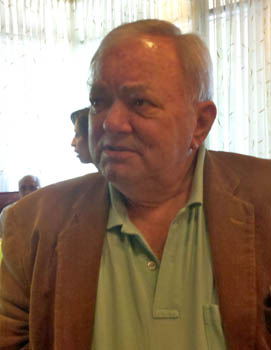
(Old Jim at the Amen Corner. Photo Socotra.)
Copyright 2011 Vic Socotra
www.vicsocotra.com
Plan B from Outer Space
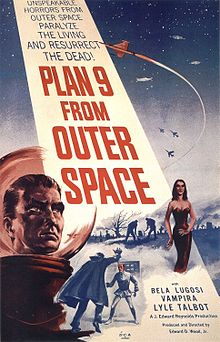
(Theatrical Poster of the Ed Wood film “Plan 9 From Outer Space.)
Oh, yeah. Sunny skies and low humidity- baby, the summer doesn’t get any better. They say the swelter will be back, just like the crisis downtown, but we can push it back a few days. I have no idea what they think they are doing- the Republicans have arrived at a schism, or something, and the Speaker did not get to a trillion in cuts, and Majority leader Reid claims whatever the House produces is dead on arrival in the Senior Chamber.
Why should we worry? They will do something, I suppose. Or not.
I was listening to a commentator on the radio who announced that the situation was patently ridiculous; absurd, in fact. Hell, we could have told him that months ago.
Maureen Dowd is starting to make the most sense of anyone. She can’t let Bush get away with what he did, but also pointed out that the Perfect Storm that elevated President Obama to the Oval Office had created the first President without a party; he has the ability to infuriate the base of his party without accomplishing his goals. She called him “President Spock,” for his cerebral disengagement from the whole tawdry spectacle.
The idea of Star Trek being a model for the Executive branch and all the talk about the various plans that cannot be enacted made me think of other bad things and after Willow and the pool, I rooted around in the faux Mission cabinet at the end of the hall where I keep the DVDs I don’t watch. When you are confronted with the impossible, you may as well embrace it.
I have a boxed set of Ed Wood films to remind me of human limitations. Ed is legendary for creating bad movies. He has several on the list of the worst films ever made, including the bizarre “Glen or Glenda,” which is a quasi-documentary about the director’s apparent struggle with transvestism.
Ed Wood is much underestimated, since that turned out to only be prescient about where American society was heading anyway, and I decided to stay with the science fiction theme and popped “Plan 9 from Outer Space” into the DVD player, bypassing the Netflex discs that have been mutely accusing me from the top of the console for months.
The 1959 film is notable for several reasons. It was a key plot device in the bio-pic Ed Wood, which It sucks, not just because it was the last appearance of legendary vampire star Bela Lugosi, but because a double was used for him after his death after filming only a few scenes. The double was a fellow named tom Mason, the chiropractor of Woods then-wife, who was bald, twice the size of Lugosi and played his scenes with a black cape held in front of his face.
That is surreal enough, but Mr. Wood was oddly prescient about politics. The plot line goes like this: aliens are seeking to stop humans from creating a doomsday weapon that will destroy the cosmos. This is bad, I presume, or so the premise goes, and thus the Aliens formulate “Plan 9” to resurrect the dead of the Earth.
These days we would call them Zombies. Ed called them by the quaint term “ghouls,” which amounts to the same thing, and is another example of Wood’s genius. The appearance of the marching ghouls creates widespread disorder, as you might imagine, and Plan 9 succeeds in saving the galaxy, even if we the living have our brains eaten by the living dead.

(Actress Maila Nurmi, Dec. 21, 1921-Jan. 10, 2008. Photo Marissa Lorraine.)
My favorite ghoul is played by actress Maila Nurmi, a Finnish-American ingénue whose blockbuster part in “Plan 9” was followed up by memorable roles in the 1960 feature films “I Passed for White,” and “Sex Kittens Go to College.” The 1962 epic “The Magic Sword” gave her a cameo, but by late that year she was installing linoleum in Los Angeles and passed mostly from the public view.
I made it through her memorable entrance in the film, when she emerges from a faux forest with her arms extended before her and a blank look on her thin face. I sympathized. I almost made it through the end of the film before I fell asleep in the Brown Chair by the door to the balcony.
In 1980, the Medved brothers wrote a book about the legendary turkeys of Hollywood. In it, they called “Plan 9” one of the worst films ever made. I have to disagree. I think it was a documentary of the future and a work of demented genius that has accurately predicted the future of American politics.
It should come as no surprise that there were dreams that followed, and that one of the characters in a particularly vivid moment was played by a man in black who kept his cape completely over his face. He never disclosed the contents of Plan B.
Copyright 2011 Vic Socotra
www.vicsocotra.com
Friends (and Enemies)
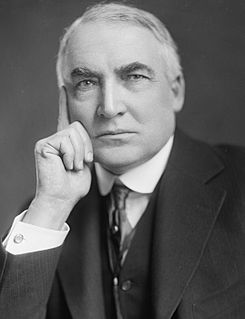
(President Warren Gamaliel Harding. Widely known as one of the worst presidents, and certainly the worst from Ohio, his “make no enemies” campaign strategy made him the compromise choice for the GOP nomination in 1920. He promised a return to “normalcy,” whatever that might be, and encouraged an “America first” campaign focused on jobs and a strong economy independent of foreign influence. He won in a landslide and rewarded friends and political hacks of “the Ohio Gang,” many of whom wound up in prison for bribery or fraud. Everyone said he was a swell guy, though, and made few enemies. Photo Wikipedia)
“I have no trouble with my enemies. I can take care of my enemies in a fight. But my friends, my goddamned friends, they’re the ones who keep me walking the floor at nights!”
– Quote – President Warren Gamaliel Harding
The rains came late in the afternoon- all water and no thunder in Arlington, anyway. Sheets of water, like God wrung out the heavens like a soaked hand-towel. The skies cleared and the temperature and humidity came down as the front moved East, and I did not have to make the hard choice about driving the block over to Willow to avoid getting wet.
People are still moving slow, wrung out in our own way by the heat wave, but the crowd at the bar rallied over time. Old Jim is getting his strength back, and Jake was having a business meeting down the bar and a couple assorted Colleagues anchored the Amen Corner. Elisabeth-with-an-S and our buddy Holly held down the business side of the liquor franchise.
The talk was about politics, and John-with-an-H’s hernia.
“There are too many people in hospital lately,” I said. “Thank God Mac is back home. I wonder how long it will be until John-with is going to be back in battery?”
Old Jim scowled. “The broken ribs didn’t hold me back,” he growled, and gestured at Elisabeth for reinforcement Budweiser. “If you don’t have any real friends you may as well come here. At least I know who is irritating.”
We are nothing if not eclectic at the Amen Corner and the conversation lurched off into an exploration of the many things that come as irritants, which these days includes the budget ceiling.
“The Republicans are getting painted into a corner. They keep proposing hard things and the President says they want to screw Grandma and fly around in corporate jets without once offering a constructive solution.”
“That is not true,” said Old Jim. “He says he will eliminate a trillion dollars in fraud and waste from entitlements.”
“Well, if it’s true there is that much fraud and waste, wouldn’t you do that anyway? He is going to be on the television tonight. I guess it is getting serious.”
“You cannot do this without making enemies,” said my colleague. “The one who looks nicest is going to get credit for the win, when it happens.” She looked doubtful. “If it happens.”
“Bobby Ray Inman had a saying about that,” I said. “Never make an enemy lightly in this town, but it you do, make sure you kill them.”
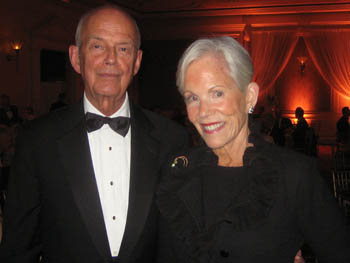
(Bobby Ray Inman and his vivacious wife Nancy at the Baker Award Dinner earlier this year. Photo Socotra.)
“Wow! Great quote,” said a young representative from a competing company. “Who was Bobby Inman?”
“He wound up as Deputy Director of CIA after being Director of Naval Intelligence, Vice Director of DIA and Director of NSA,” I said. “He is a legend to all of the Navy spooks. He always thought a couple moves ahead of everyone else and was the first Spook to make four stars- a full Admiral.”
“Send me the quote, would you?” I nodded and made a note to myself on a napkin, and then drafted a non-disclosure agreement about a potential business venture on another.
My Colleague tucked the latter in her purse and I tucked the reminder in the inside pocket of my seersucker jacket. The amount of Happy Hour white wine consumed and time remaining to get in the Big Pink pool for a decent swim arrived just after seven, and I wandered back to the office to collect the car and get home.
The torrent of rain had cooled the waters and Martin the Polish lifeguard looked relieved at the moderation of the temperature. He has been cooking in his own juices on the deck for the last week. I listened to my iPod while I paddled, the device protected by a waterproof case on my arm. The nice people on NPR said that the President would be along presently, and I was toweling off as his address from the Oval Office commenced as Martin padlocked the pool deck for the night.
I listened to both versions of reality with mild disbelief. I mean, nothing should surprise me any more, but this little psycho-drama is pretty surreal. Mr. Obama had some nice rhetorical flourishes, using standard English instead of that shuck-and-jive thing he does when he is trying to convince us he is just folks. A key point appears to be to get the next debt ceiling increase beyond the 2012 election.
Then, Speaker Boehner came on and trashed the chief executive, and wants the crisis to continue through the election cycle. I shook my head. We cannot afford the Democrats, and we cannot afford the Republicans, either. Something has got to give, but I don’t know what. I poured a drink, turned off the radio, went out on the balcony and wondered why I had never got cushions for the hard wood of the Adirondack chair and eventually went to bed.
When I rose at five, I looked at the napkins in the pile next to the computer. I searched a bunch of sources for the Inman quote. And could not find it. I did find its eventual patrimony, since it appears to be a modification of this traditional wisdom:
“If you’re going to shoot the king, don’t miss”
I had to think about John Kennedy, sadly, since we have been investigating that sorry moment in American History of late, with an emphasis on the Texas accent of the man who replaced him.
That phrase, in turn, has evolved from the words of Niccolò Machiavelli (1469-1527). who wrote in the seminal political primer The Prince: “Never do an enemy a small injury.” If one is striking out at an opponent, one should make sure that the fatal blow is struck, successfully ending the confrontation.
Machiavelli was of the opinion that “the injury that is to be done to a man ought to be of such a kind that one does not stand in fear of revenge,” and I can’t say I disagree with him.
A well-known anecdote in the literature (cited since at least 1882) concerns an ambitious young academic who wrote an essay criticizing Plato (like Plato could care at that point), and sent it to legendary poet and wordsmith Ralph Waldo Emerson for comment. Emerson found the logic in the essay less than compelling, and returned it with the red-pen remark: “When you strike (at) a king you must kill him.”
It has passed into the popular lexicon from there, normally beginning “If you shoot at the king” or “If you’re going to shoot the king” or “If you aim at the king.” The ending “you must kill him” is often replaced with “you better make sure he’s dead,” or “don’t miss.”

(Noted bartender, Lawyer and Public Policy aspirant, Elisabeth with an S. Photo Socotra.)
It is a popular adage with politicians, lawyers and bartenders. I would have to ask Elisabeth about that- she is the only person I know who is trying to do all three.
The saying has often been applied to politicians seeking to change the leadership in his or her political party. Like Eric Cantor, who apparently views Speaker Boehner as a hood ornament to his intransigent agenda. It is normally a high-risk strategy, since if the “king” is not “killed,” the party leaders will seek revenge. Everyone in this saga appears ready to make some enemies, and force the opponents into corners. The hope on both sides appears to be for the destruction of the other in the public opinion, yet they are all still going to be standing even if the government shuts its doors.
Time is running out, the lines drawn in the sand, and somebody has to blink this week and make nice, or we have the train-wreck.
Bobby Ray’s version of the wisdom, I recall, is uttered with a Texas drawl. It will be interesting to see how this all turns out, don’t you think? I wonder what Warren Harding would do? Like Speaker Boehner, he was from Ohio.
Copyright 2011 Vic Socotra
www.vicsocotra.com
Mac Update
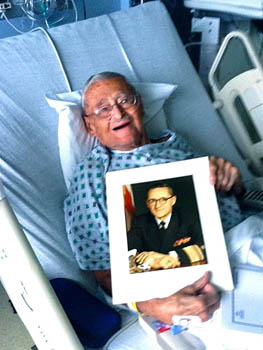
(Mac on the rebound. Photo Socotra.)
Sunday was not as awful as it could have been. No great progress on the continuing budget crisis, or so it seems, and the wet soaking blanket of humidity continued to drape over the capital. It is enervating weather, sucking the energy out of my pores and causing me to puddle up where I sit.
They say that it may break today, with thunder-bumpers sweeping across the region in the afternoon. Mac missed the whole thing. He has been over at Arlington Hospital since his temperature spiked last week along with the weather, in a private room on the 8th floor of the tower.
He sounded pretty good when we talked on Saturday, and I made arrangements to visit him Sunday afternoon with our mutual pal Kimo, who is packing out his house to go take Mac’s old job in Hawaii.
Hospitals are funny these days. I asked when visiting hours might be, and Mac said there weren’t any. Confused, I asked if that meant we could not come, and he laughed and said, “No, it just means you can come any time you feel like. This is OK- I can order my meals any time I am awake, too, and you should see the macaroni and cheese they have. Much better than the mac at The Madison. Theirs is too dry.”
“We all just want to see the Real Mac back home where you belong,” I said with concern.
“They may release me on Monday,” he said. “The Quacks will evaluate then, but I feel a lot better.”
“That is encouraging, Sir,” I said, and wished him good sleeping in the cool while the rest of the city sweltered.
I filled Kimo in on the situation as we buzzed up George Mason from Route 50. I had the top down, and regretted it as sweat rolled down my neck and into the collar of my polo shirt. It being Sunday, there was parking at the curb on George Mason, and I slid the Hubrismobile in behind a hulking Escalade SUV and raised the top.
“Nineteen precision German motors involved in this evolution,” I said as the soft-top emerged from the trunk and the hard glass of the rear window did its little pirouette to dodge the hard deck and latch itself securely. We walked up to the hospital lobby, passing the sign advising us that no cell phones were permitted, and took the World’s Slowest Elevator to the eighth floor.
Mac had told me he was in room 815, near the nursing station, and he told us to come right in when I rapped on the doorframe.
“Well, look who is here! Kimo, when do you leave for Hawaii?”
They chatted up the details of the coming move. Kimo had worked with Mac on a historical display in the basement of the CINCPACFLT Headquarters building- I still call it that, though Uncle Don Rumsfeld’s imperious change to the names of the Combatant Commands and the Pacific and Atlantic Fleet.
“There is only one Commander in Chief,” his SECDEF decision memo announced primly, “and that is the President. Accordingly, there will be a PACOM COMMANDER, and a ComPacFleet. No more CINCS.”
Kimo had a large picture of Mac when he was still on active duty, and he made a little ceremony of presenting it to him, and I managed to snap a picture with my iPad. “You have a heck of view here,” I said, as a couple buddies from The Madison entered the room and we all clustered around the bed.
“Admiral, let me ask you, did you know Noel Gayler?”
“Oh, yes,” he said firmly. “I remember the last time I talked to him. It was in the Pentagon. He was down from Fort Meade where he was DIRNSA. There was a regular Friday breakfast between the Director of DIA and NSA and SECDEF Mel Laird.”
“You were DIA’s Chief of Staff then, right?”
Mac nodded and adjusted the clear oxygen tube under his nose. “Yes. I had to prep General Bennett for the meetings with the status of current issues. He and Noel were both three stars, and he became convinced that I was setting him up. Nothing further from the truth, and whatever was going on was coming from General Bennett. But that one day Noel saw me and he came steaming up full-throttle and said he was really pissed at me.”
“I heard from Jinny that he was pretty full of himself when she and Barney met him in London when he was the ALUSNA. He had dumped his wife Caroline and was looking around for someone new.”
“I think I met Kay one time. But three stars and command of an independent Agency can do that to you,” smiled Mac. “And he is one of the few officers to get a promotion out of NSA to be CINCPAC. I never talked to him again after that scene in the E Ring of the Pentagon.”
“Well,” I said, “Even if General Bennett tore him up in front of Secretary Laird’s intelligence chief, he did OK. You know Keith Alexander got his fourth star and he is still at NSA. He is the new CYBERCOM Commander in addition to being DIRNSA.”
“These things run in cycles, just like the wars. Laird trusted him, for whatever reason, and there was a lot going on: the end of the draft, the winding down of Vietnam and all the rest. Interesting times.”
“There is a saying about that,” I said.
“What is that?” asked Mac.
“May you live in interesting times is supposed to be a Chinese curse.”
Mac smiled. “Then I guess that is exactly where we are.”
Copyright 2011 Vic Socotra
www.vicsocotra.com
The Last Hero of the Coral Sea: ADM Noel Gayler, USN
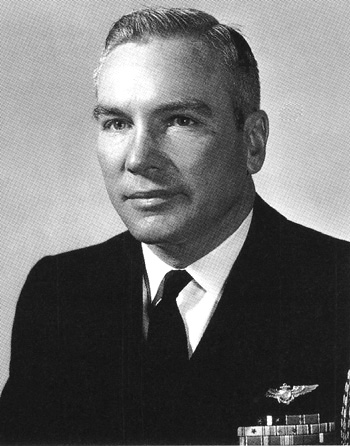
(ADM Noel Gayler in his office at Camp Smith, HI, 1976. An authentic hero and warrior, he was proud of being the first no-nucs officer to head the Pacific Command. Photo New York Times.)
It has been so hot the last few days that I think my brain softened. I saw the note in the news a couple days ago, and it did not penetrate at the time that one of the last of my pal Mac’s contemporaries had passed on. Mac is in the hospital- apparently on the mend, thank God- and I was thinking about getting back to my notes about the tumultuous decade of the 1970s. Bad as it was, at least the 70s are over. What is next for us is not.
It was either that, or continue to worry about the game of chicken being played by both sides in the debt ceiling psycho-drama, or the mystery of the twin interlude of slaughters in the placid nation of Norway. The former will work it self out, or not, and the latter will require more information on what sort of mirror image al-Qaidas we are going to be dealing with in what once was the West.
So, I dug out the notes I have been playing with idly over the weekend, waiting to see if my brains were really going to melt out of my head. There it was, the formal obituary that the Times of New York would have to correct, since they do not know their ass from a hole in the ground about military matters. Here is how it might have been written by someone else in the business:
14 July 2011. ADM Noel Arthur Meredyth Gayler, 96, Alexandria, VA, of natural causes. He was the sixth Director of the National Security Agency (DIRNSA) at the height ot the Vietnam War, and followed a unique career path to four-star rank. He began his service as a surface warrior, became one of the highest –decorated fighter pilots in Navy history, and retired as the ninth CINCPAC from 1972 to 1976. His story-book career spanned 46 years of active duty and three wars, a unique wartime flight in a Japanese Zero fighter over the US Capitol, complete with the round red meatball of the Empire painted on the fuselage, and a position as the first anti-nuclear commander of CINCPAC, the military minister plenipotentiary for the United States at the zenith of its power in the Pacific basin.
Noel Arthur Meredyth Gayler was born in Birmingham, Ala., on Dec. 25, 1914, one of three children born Ernest and Anne Roberts Gayler. His father was a naval officer, who inspired him to enter the US Naval Academy in the class of ’35. His first assignment as an Ensign was in the Engineering Division on the battleship Maryland (BB-46). After an initial stint in the “Gun Club,” he transferred for his department head tours in the destroyer Maury (DD-401) followed by service as the Gunnery Officer on the destroyer Craven (DD-382).
Life as a “Tin Can” sailor paled for ENS Gayler, who saw that there was a new path to success in the service as the carrier air capability was ramped up in anticipation of war. In March 1940, Gayler entered Flight Training at NAS Pensacola, the cradle of Naval Aviation. He was designated a Naval Aviator in November 1940, and was assigned to the Pacific in Fighter Squadron THREE (VF-3). He joined one of the most storied ready-rooms in Navy history. The “Felix the Cat” squadron was commanded by the legendary Jimmie Thatch who was credited with inventing the “Thatch Weave” formation for air combat patrols, and who would later go on to make four stars and command naval forces in Europe. Another squadron mate was Medal of Honor recipient Edward “Butch” O’Hare.
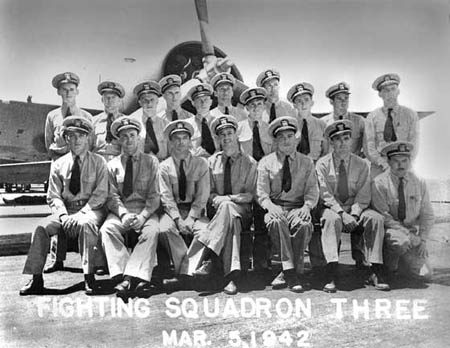
(VF-3 Squadron portrait. Noel Gayler is third from left in the first row, immediately next to Skipper Jimmie Thatch. Medal of Honor winner Butch O’Hare is sixth from left.)
VF-3’s “Fightin’ Felix” pilots were mentored by Thatch into a fighting machine that was prepared to take on the undefeated Japanese carrier force and it’s nimble fighters and demonstrate that the rugged Grumman fighter was in fact superior to the Mitsubishi Zero-sen aircraft when properly employed.
After Pearl Harbor the first important sea battle between American and Japanese forces was shaping up, and US Naval forces began to probe the perimeter of the massive new Japanese empire. Noel Gayler’s first Navy Cross was awarded after:
“…his ship was attacked by eighteen Japanese bombing planes on 20 February 1942. In the face of heavy antiaircraft fire, Lieutenant Gayler intercepted a formation of nine enemy aircraft and succeeded in shooting down one twin-engine bomber and a seaplane fighter, and aided in the destruction of two other twin-engine bombers, and bombed and strafed two enemy destroyers.”
In March of 1942, planes from the Enterprise had hit Japanese-occupied Wake Island, and Lexington (CV-2) teamed with Yorktown (CV-5) to strike enemy bases at Lae and Salamaua on the island of New Guinea.
Intelligence derived from Station HYPO decrypts of JN-25 Naval Code indicated that the Japanese were planning to invade Port Moresby, near the eastern tip of New Guinea. The main body of the task force would sortie around this eastern tip, into the Coral Sea, and then attack.
Port Moresby was vital to Allied strategy, since if the Japanese established a presence there the strategic sea-lanes to Australia and New Zealand would be compromised. ADM Chester Nimitz made a bold role of the dice, ordering the bulk of his carrier force to engage. Lexington and Yorktown were ordered into the Coral Sea to intercept the Japanese battle force.
On the morning of May 5th, the two carriers heard a report from Lieutenant Commander James “Jimmie” Flatley, who led the Yorktown’s fighters. He was flying on Combat Air Patrol (CAP), and had spotted a Kawanishi flying boat spying on the task force.
“Where is he?” inquired Combat on Lexington.
“Wait a minute and I’ll show you,” radioed Flatley.
A fireball erupted in the clouds as his Wildcat gunned down the lumbering flying boat.
On its way down, the big plane almost struck LT Noel Gayler’s Grumman F4F Wildcat where he was orbiting near Lexington.
“Hey, Jimmy,” he yelled, “that one almost hit me.”
“That’ll teach you to fly underneath me when Japs are around,” Flatley quipped on the tactical frequency.
During the Air Battle of the Coral Sea three weeks later, Gayler’s aggressive courage earned him another Navy Cross, where with “…utter disregard for his own life…he succeeded in destroying two enemy Japanese aircraft and in damaging two others.”
Three days later, he gained a third Navy Cross when on 10 March he intercepted and shot down an enemy seaplane fighter. “In the face of heavy anti-aircraft fire he (then) conducted a vigorous and determined dive-bombing and strafing attack on two enemy destroyers, causing many personnel casualties.”
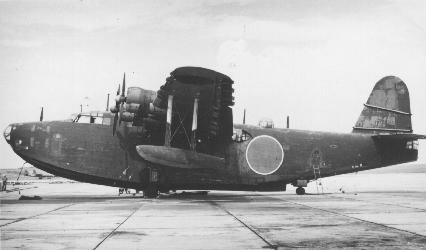
(IJN Kawanishi flying boat. Photo US Navy.)
In June 1942, on the eve of the Battle of Midway, Gayler was transferred to NAS Anacostia in Washington, DC. The U.S. Navy pulled its best combat pilots out of action to train newer pilots, while the Japanese kept their best pilots in combat. At NAS Anacostia he served as the Fighter (VF) Project Officer at BuAer From June 1943 to June 1944 to develop the improved Grumman fighter- the F6F Hellcat.
He had a stake in the new aircraft, since subsequently served as a test and evaluation pilot at NAS PAX River. He returned to combat as Commanding Officer of VF-12 from June 1944 to February 1945, and was Air Ops for the 2nd Carrier Task Force from March 1945 through the end of the Pacific War.
It was in his capacity as Task Force Air Ops that Gayler was able to commandeer an aircraft do conduct an aerial tour of Hiroshima. He was not the only interested tourist to visit- the pilot of Bock’s Car, the B-29 that dropped the second atomic device on Nagasaki toured the city a few months after the peace, and continued to believe the strike was the right thing to do, and that it had saved hundreds of thousands of lives.
Gayler did not see it that way. He flew over Hiroshima six days after the first atomic bomb was dropped on Aug. 6, 1945. “He was stunned; he saw nothing moving,” his widow Jeanne commented recently. “It was imprinted on his mind, and he vowed to work to eliminate nuclear weapons.”
Gayler was present on the USS Missouri (BB-63) for the official surrender ceremony, and Operation MAGIC CARPET whisked him and millions of other servicemen home that November.
Jeanne Mallette Thompson Galyer’s recollection of Gayler’s memories of Hiroshima (Gayler’s first marriage ended in divorce) may contain a bit of historic revisionism, since despite his qualms about the horror of Hiroshima, Noel Gayler was destined to become the navy’s consummate nuclear warrior.
With the return to CONUS, he was assigned as Executive Officer and then Deputy Director of Special Devices Center on Long Island, NY, 46-48. The Center had been in the center of technology throughout the war, growing in prominence from a Section to a full-fledged Naval research center. It had explored technologies like television and innovative training devices for precision bombing and terrain modeling for aerial targeting.
The latter was a key element of Air Intelligence Targeting and was one of the key product lines of the CINCPACFLT intelligence division. In addition to the general knowledge of what Special Intelligence- the ability to accurately forecast enemy intentions to permit the bold strike- Gayler was attuned to the value of technology. Gayler’s Center was on the cutting edge of everything, and was also the home of the Navy’s first mainframe computer.
The command was also not far from the estate where Naval Intelligence exploited captured Nazi and Japanese technology, and there was frequent interaction. He also deployed from the Center to observe the third US atomic test series: Operation SANDSTONE, a three detonation series to test the effects of atomic weapons on surface ships.
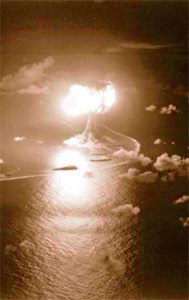
(Operation SANDSTONE blast at Eniwetok Atoll, 1948. Official US Navy photo.)
In 1998, he commented to interviewer Steve Sapienza that: “I saw Hiroshima. Utter desolation. Not a thing moving. A little old dinky bomb did that. I participated in a second, I think it was, group of nuclear tests in the South Pacific, the Sandstone Series and I first saw what these things looked like, little thing from nineteen miles away is like the end of the earth. And I realized that the ideas about protection of ships — Navy — run away from the base surge, wash down of decontamination — all of that stuff was just nonsense. And I think — I think — by the way, something funny happened. Hard to believe you could be funny about nuclear testing, but we discovered that the sailors were kind of disappointed with us after all the work they’d done, washed down and whatnot, nothing much was happening until finally some character put a Geiger counter on the top of the cabinet [inaudible] and by golly, a passing sea gull had made a deposit there and it was radioactive. And everybody was happy.”
He managed to internalize his misgivings about the nature of his profession and was a consummate Navy leader in his combat and peacetime assignments afloat. These included duty in increasing levels of responsibility as Operations Officer in USS Bairoko (CVE 115) ‘48-49, CO of the deep draft USS Greenwich Bay (AVP 41) 56-57, Major command of USS Ranger (CVA 61) 59-60, and Flag command as Carrier Division (CARDEV) TWENTY, 62-63.
His shore assignments attuned him to technology, acquisition, politics and Human Intelligence operations, and the expose to the nature of how the Navy’s nuclear capability kept it at the heart of the strategic balance between the warring services.
Ashore, he headed the Fighter Design Branch in Washington, D.C., ‘49-51, and commanded VX-3 at Atlantic City, NJ, 51-54. In that job, he once flew from NAS Oceana east of Norfolk, Virginia, to Denver, Colorado and return nonstop. The entire flight was flown below 200 feet in altitude to demonstrate feasibility of low-level penetration and attack. Gayler reported “Lots of astonished cattle” on his return.
He finally emerged from the cockpit to serve in the pressure-cooker OpNav Staff in the Pentagon, 54-56, He was Operations Officer for the Commander in Chief, Pacific Fleet, from February to June 1957, and then served as a Naval Aide to the Secretary of the Navy from June 1957 to April 1959. He was selected to be the U.S. Naval Attaché in London, England, from August 1960 to August 1962, a job that required regular intelligence reporting on events in the Court of St. James. He returned to the Pentagon late that year to become Assistant Chief of Naval Operations for Development.
Misgivings about weapons aside, his office was in the middle of the Submarine Launched Ballistic Missile program- in August 1967. He was Deputy Director of the Joint Strategic Target Planning Staff at Offutt AFB, Nebraska, from September 1967 to July 1969.
JSTPS was charged with planning Doomsday. It was the high-custodian of the Single Integrated Operation Plan, or “SIOP.” On a regular production cycle, the staff constructed the nuclear target deck for the manned bombers, submarine-launched and silo-based ICBM force.
In a 1976 interview after retirement, Gayler mused about his time there: “A very few persons go about the grim, necessary business of nuclear planning. Fewer still have seen a bomb tested: the light of a thousand suns, searing heat, immense shock, a wicked flickering afterglow manifesting in intense residual radiation. That’s a pity. We and the Soviet Union have tens of thousands of weapons. We better get them under control.”
From that position, ADM Gayler was nominated by President Nixon to become the 6th Director of the National Security Agency in July 1969. Nixon, urged by his National Security Advisor Henry Kissinger, to assign officers with broad operational experience- not intelligence professionals- in order to better control the intelligence community.
Gayler presided over the NSA SIGINT program, including clandestine and space-based reconnaissance, until Nixon nominated him to be chief of the U.S. Pacific Command (CINCPAC) in August 1972. In that capacity he managed the closing act of the Vietnam War.
In that post, the Admiral was in charge of all American armed forces in a 94-million-square-mile area from the west coasts of North and South America to the Indian Ocean. He was the American military adviser to the Southeast Asia Treaty Organization (SEATO). He was no opponent of conventional bombing, and oversaw the American air campaigns against North Vietnam and the secret bombing of Cambodia and Laos.
He retired from the Navy the year after Saigon fell to Communist forces, and in the same year wrote an Op-Ed article for The New York Times he was critical of the American nuclear posture, and increasingly too a position at variance with the official national strategy of massive retaliation.
His activism gained him notice as a military maverick. In 1986, he received an invitation from Jeanne Malette Thompson to join an organization she had founded (with activist Carl M. Marcy) called “The American Committee on East-West Accord.”
According to the mission statement, the organization intended to “promote rational relations with the Soviet Union and to work toward nuclear disarmament.”
The gravitas of the board that Admiral Gayler joined is unassailable. It included such Cold War giants as: Robert Strange McNamara, George F. Kennan and John Kenneth Galbraith, all of whom had crises of faith in the doctrine of containment and mutually assured destruction.
Soon after joining the board, he married Ms Thompson.
In December 2000, working with an organization called the Nuclear Age Peace Foundation, Admiral Gayler wrote a proposal for the elimination of all nuclear arms. “When a target country can be destroyed by a dozen weapons,” he wrote, “its own possession of thousands of weapons gains
no security.”
He continued a vigorous campaign against nuclear weapons until shortly before his final illness.
In addition to his wife Jeanne, he is survived by two sons and three daughters from his first marriage, two stepsons, a stepdaughter, and five great-grandchildren.
He died peacefully at his home in Alexandria, Virginia, the last and most prominent of the remaining heroes of the Coral Sea. Burial arrangements were not disclosed as of press time.
Copyright 2011 Vic Socotra
www.vicsocotra.com
Buildings

(Willow in July. Photo Socotra.)
We could not get any further than Clarendon on the Metro. The train had seemed like the right way to get out of town, where we had business in the Chinatown district adjacent to the old Convention Center and the Bus Station, where I worked in the towering structure that had been thrown up on New York Avenue above the classic Art Deco façade of the old terminal.
A cab would have been hung up in the rush hour traffic, and the moisture made the air shimmer as we made our way on the blazing streets toward the Metro Center subway. The parking lot that had been the Old Convention center next to the bus station is now a deep pit, I was interested to see, and the excavations had got down to about four stories below street level.
“Apparently the Qataris are backing the project. It is supposed to have a high-end hotel, a thousand apartments and a bunch of other crap. There is going to be a central plaza with a half-acre of open space, and will create a destination right here on New York Ave, not far from the New Convention Center. I swear, it used to be worth your life to come down here.” I shook my head. “Amazing. Now it is going to be a destination.”
I gestured toward the Hyatt, whose soaring atrium would provide coolness against the heat. We walked in through the revolving doors and past the delegates to the Export Control Conference with their convention badges, and looked at the blue waters in the vast fountains that cover the lower level of the hotel and radiate cool calm at the base of the escalators.
The office complex adjacent can be reached through a grand portal off the hotel atrium, and has another escalator that accesses the tracks at Metro Center far below.
Down there, I thought, the air would be cooler, and at rush hour the trains come with a frequency that mimics a real public transportation system. We got past McPherson and Farragut Squares, and Foggy Bottom and Rossyln and Courthouse, but that is where our luck ran out.
At Clarendon the train glided to a stop, hitched briefly, and then sat with the doors open.
The conductor made periodic announcements, which were garbled the way CIA Director William Casey used do when he would testify to Congress and didn’t want them to understand he was invading Nicaragua or El Salvador, I forget which.
We waited long enough on the train that we could have walked up past Virginia Square and right to Ballston where we intended to have some crisp happy hour white to beat down the effects of the heat. “It is important to stay hydrated,” I said as we marched up the sun-drenched street.
I pointed at a distinctive pyramidal building across the street from a Chinese restaurant that people used to claim belonged to the People’s Liberation Army. The Agency I used to work for rented that building over there,” I said gesturing. “They had to justify the money for new construction since you can see how crappy security is here, with the Metro almost running underneath it. That is when the hemorrhage of money after 9/11 began to scare the government.”
We walked along in silence, sweating, and made it past Virginia Square and the Ballston station in good order.
In the cool darkness of Willow, Old Jim was chatting with the Lovely Bea, Jon-with-no-H and Jake was conducting business up the bar. I asked Big Jim the bartended for a glass of water to go along with the crisp happy hour white, and talk turned, eventually, once we had smeared every other issue, toward the construction that is still booming in town.
“Doesn’t seem to matter if the government is going to shut down. The beast just keeps getting bigger and bigger.”
Jake finished his beer, gestured for the check and wandered down to press the flesh. I asked hi about the building we had both regardless of the Government of the completion…There was this guy named Dubois- he was the successor to D.O.C. Cook, the old Mayor of the Pentagon who had been there forever.”
“Yeah, I knew him before they named the DOC Cook Remote Delivery Facility for him.”
“Appropriate to name a loading dock for him.”
“Anyway,” said Jake, “we had to go to Dubois and explain why we needed to clear out the building in Clarendon. We were going to justify it on Force Protection issues….”
“Yeah, of course, the garage is open to the street and you could drive a VB-IED there and do a number on the structure….”
“Well, Jim Manzelmann was Director of the Naval Reserve Intelligence Program at the time and in private life he was the architect of the DIAC Expansion.”
“I remember we couldn’t call it that for a while- it sounded like the Agency was Expanding, which was considered bad on the Hill…we had to call it “DIAC Completion,” like it was something we planned all along.”
“Well, we knew what it was. But because Jim got tipped off, we went in saying that it was about increased survivability. The pond in front…“
“You mean Lake Manzelmann?”
“Better than Lake Jake! Yeah, we said it was to give us additional cooling capability, and that being on the Air Force Base gave us better cross-connectivity- the Uninterrupted Power Source of the new building would enable us to continue the mission regardless of what happened. It was about survivability.”
“Everyone else was saying that it was a force protection issue and we had to disperse into scattered facilities.”
Jake nodded. “We went the other way and said we were consolidating, and that is what did it. We were one of the few buildings that got approved.”
I shook my head. “It pays to have agents on the Hill, doesn’t it? I sort of wish the taxpayers had some up there, too.”
Copyright 2011 Vic Socotra
www.vicsocotra.com
News of the World

(Butterfly stroke, or Dolphin, in the Big Pink pool.)
The heat was as wet as a damp washcloth. Adam, the Pole from Podlaska, had firm control of the pool deck with his bluff friendly manner. He is a big guy, muscular, if a little soft in the waist, an East European version of a Minnesota interior lineman.
Podlaska is so far east that it is almost in Belarus, one of he several Soviet Republics occupied by the Germans, and which before that had been known as White Russia.
Adam looks like his great-grandfather might have been one of the Whites who fought the Reds in the early days of the USSR. Things were slow in the languid heavy air by the pool, and he abandoned his post under the umbrella by the gate and got in to slosh the blue water with a powerful dual-overhand stroke.
“Nice Butterfly,” I said, after he completed an underwater racing turn and stood up in the shallow end.
“We call Dolphin,” he said. “But I thank you.”
Jiggs popped out of the building, carrying his towel and goggles. “Stock market was up two hundred points,” he said. “What’s up with that?”
My Associate and her lovely mother sat on the edge of the pool, limbs in, soaking up the humidity. Their hair seemed to expand by the minute. I shook my head. “Don’t know. We had a late lunch at Willow and a little wine to start the happy hour early. We did not pay any attention to the market.”
“Think there was progress on the debt ceiling?” he asked.
“Can’t think of anything else that would cause the markets to go up,” I said. “There was some talk about the Senate producing a compromise now that the House has got the balanced budget thing out of its system.”
“You mean a grand compromise at this late date?”
“Maybe. It will require some magic, but maybe the markets were reflecting relief that someone is acting like a grown-up.”
“We could use some of that,” said Jiggs and grimaced as he stepped down the stairs into the water that retained some of the coolness of the night. “But the last hard news I had was about Rupert Murdoch’s wife decking a guy in Parliament who was going to hit him with a cream pie.”
“Now, that is news you can use,” I said.
“News of the world,” said Jiggs, and submerged.
Copyright 2011 Vic Socotra
www.vicsocotra.com
Cut, Cap and Whatever
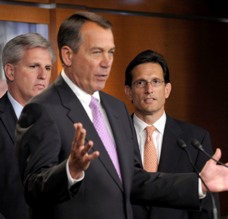
(Speaker Boehner castigates the President in a press conference shortly before the President promised to make everything OK with justice for all. The Speaker later decamped to Ramparts for a beverage and a smoke. Photo UPI)
The moist heat has returned to Washington. I have the door to the balcony open, and the breath of the sultry heat to come as morning rises makes my hair bushy and my shirt cling to my chest and arms. I am puzzling this morning over the pirouettes the dancers are playing downtown.
Sorry about this, but I feel a little like a mongoose looking at a Cobra in rapt fascination. I mean, this is a big deal, right? Isn’t it?
Based on the reports this morning, the warring sides are still far apart on the debt ceiling, but have to come to some sort of agreement by the weekend.
It is quite surreal, and there is plenty to watch, since this show takes place in a three-ring circus. In the one under the dome of the Capitol, the House is formulating a “Cut, Cap and Balance” bill, which would:
CUT
Total spending by $111 billion in FY 2012. The savings are harvested from freezing non-security discretionary spending below 2008 levels, which saves $76 billion, a $35 billion cut to non-veterans, non-Medicare, non-Social Security mandatory spending and keeping defense at the level requested in the President’s budget.
CAP
Total federal spending would be scaled back based on a glide path that would take Federal spending from 22.5% of the Gross Domestic Product (GDP) next year down to a hair below 20% by 2021.
BALANCE
Require the passage of a Balanced Budget Amendment before raising the nation’s debt limit.
It is going nowhere, of course, since Mr. Reid in the Senate will not countenance it. Besides, a constitutional amendment like the Balanced Budget element would require two-thirds majorities in the House and Senate, and ratification by 38 States before Saturday, and the President has said he would veto it anyway.
So it is just political theater, and a considerable distraction that will push negotiations to the brink, but still provide political cover for the Republicans who have signed the Norquist pledge to not raise taxes.
Poor Republicans. They had the temerity to actually say what they were going to do. The President’s grand plan remains a mystery. And, of course, taxes are going up at the end of next year anyway with the expiration of the Bush rates, so I am bemused by the whole thing.
The Speaker was smoking and drinking at the Ramparts pub in Shirlington last night according to my sensitive HUMINT sources, after castigating the Administration in a press conference at 3:15pm, shortly before I decamped to Willow. Old Jim is still out with broken ribs, and John-with-an-H is going to undergo surgery on Thursday.
His doctors have advised him to stop drinking soon, and as you might imagine, he is not a happy camper.
The phlegmatic bureaucrats have been directed by the White House to prepare for a shut-down of the government.
There is, naturally, a cascade of actions that would keep the interest on the debt paid while curtailing less vital functions of government, though that could impact our pension payments, and social security. I will be interested to see if that comes to pass. I forget what I pay out of my pension on the first of the month- I guess I will have to curtail payment to the Ex of part of her maintenance. I wonder if the Republicans are aware of that?
Trust me, the last thing you want is her angry.
I will promise to make it up later. The Government seems to be able to do that, so why not the rest of us?
What was on the table before the Cut Cap and Whatever show started was a budget plan that would slice a “record” $33 billion from current spending levels. 33 billion from a budget of nearly $3.83 trillion with a federal deficit this year predicted to be around $1.56 trillion.
It is mind boggling, isn’t it?
There is no meeting at the White House this morning, as far as I can tell, since they have to get the charade of the Cap, Cut Whatever out of the way.
The White House yesterday reaffirmed Mr. Obama’s smoke-and-mirrors pledge to cut four trillion out of the budget from unspecified reductions while “supporting economic growth and long-term job creation, protecting critical investments, and meeting the commitments made to provide economic security to Americans no matter their circumstances.”
That will be a pretty good trick. I guess both sides have to get it out of their systems before they can actually do their jobs.
Informed observers have said that “a shutdown still appeared less than likely at this point, as neither side would benefit if their inaction closed everything from passport offices to bankruptcy courts.”
One commentator chose a sports analogy to calculate the odds. “Odds remain above 50 percent that the government will not shut down on Saturday, though it is close to a jump ball.” I would like to see the President face off with the Speaker on that one, one-on-one, and leave the rest of us out of it.
I wonder what the company will tell us to do, if there isn’t any government to talk to next week. Go into the office and look at our phones?
Copyright 2011 Vic Socotra
www.vicsocotra.com
